Over the last little while, it become evident how frustrating Frostbite tokens can be if you aren’t ready for them. Over the course of Limited season, and even from the Constructed gameplay we have seen so far, Frostbite can completely shut down turns. However, I do want to illustrate that with some tactical and deckbuilding changes, you can reliably work around Frostbite and adjust to its effects without drastically losing out on your ability to win games.
Before you do read the rest of this piece though, I do want to state that this of course isn’t a remedy for Frostbite entirely. If your opponent manages to land three of the tokens on you then yes, your next turn is probably screwed. However, one or maybe even two is much more manageable than you think, and if you adjust, it can really nullify a critical part of your opponent’s deck.
At the earliest watch, this is the most obvious remedy to Frostbite. “It taxes my pitch. Great! Let’s add more!” Although this is true to a certain extent, I really don’t think it’s going this is the only way around those nasty tokens. By adding in more blues, you’ll be giving up more on the other side of the coin, either in offensive output or simply changing your game plan. I do recommend adding a few more blues, into your deck, but rather than switch them into the core, maybe add them into your sideboard for when you do have to deal with those Frostbite ridden matchups. In addition to this, go slow with the adding of blues, and really see how much it hinders your hand quality simply in the need of Frostbite negation.
The decks that are most punished against resource taxes are those that are the most linear. An example of a linear turn of off a three-card hand would be such:
- Play an Earthlore Surge (Red)
- Pitch a Vela Flash (Blue)
- Play a Heaven’s Claws (Red), attacking for 10
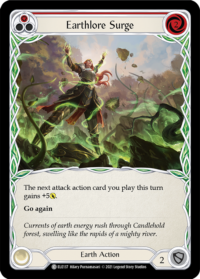
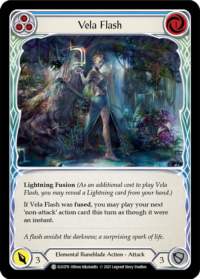
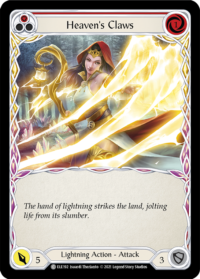
Although this is a strong turn, it has very little flexibility, and outside of this play line, there isn’t much else the turn can do. Add in that the turn completely uses up the resource base of the blue that is pitched and a single Frostbite can become backbreaking for the player. In the case of this hand in particular, it can easily mean attacking for five rather than 10 and having a complete dud of a turn.
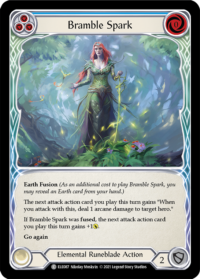
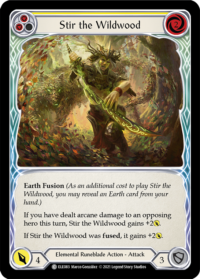
This is where flexibility is now extremely important, and it’s something you must build into your deck building at the very foundations. When planning out synergies and plays you can draw into, you need to try to maximize the variations of play you have per hand. Briar, and Runeblades in particular, are incredible at this. A hand with a Bramble Spark (Blue), a Mauvrion Skies (Blue) and a Stir the Wildwood (Yellow) could playout best by using the Mauvrion Skies first, and then the Stir, this would float one resource from the pitched Bramble Spark, which subsequently could be used for the Rosetta Thorn attack. In the case of a singular Frostbite, you could possibly even pitch the Mauvrion Skies to play out the Bramble Spark and Stir the Wildwood. In the case of more than one Frostbite, you could simply pitch both cards to play the Stir or play out both non-attacks to create that valuable Embodiment of Lightning token for a future turn. This is strong flexibility; three cards, but four possible play lines which are all valid depending on situation to situation.
Moving into a meta where your opponent can disrupt you so readily will require these thought processes to be included in deckbuilding. Be very wary of cards that cost three since with a single Frostbite, their play becomes almost invalid due to their now extreme resource costing of four. In the same manner, weapons that cost a lot to swing such as Titan Fist and Dread Scythe should be carefully added into your deck, as the original strong one-card hand that they presented is essentially invalidated going forward if you have a Frostbite token.
More than anything, you need to understand that this meta is going to have a lot of give and take. Heroes like Oldhim and Lexi have surefire ways of getting Frostbites through your defenses no matter how hard you try to avoid it. Rather than mentally breakdown in frustration, use the Frostbites as resource sinks and simply set up the bottom of your deck for stronger turns later. The strength of many of the best Frostbite generation cards will wane through the game, with most of the relevant on-hit effect attack actions and non-attacks moving into graveyard as they are played out. Be patient and defend well, saving your life total so that when you start sensing that your opponent’s freeze over game plan is starting to thaw out, you can come at them with a blast of heat they won’t be able to handle.
Between tactics and deckbuilding, Frostbite is a token we can work around, but come into matches unprepared, and you’ll easily find yourself frozen over before you know it. Try to adjust your pitch count, and work on your hand flexibility in the deckbuilding process, whilst adjusting the game plan and patience level as game time rolls around. Hopefully the next time you sit down on the other side of a Ice hero now, you’ll be the one to leave a frozen look on their face!






